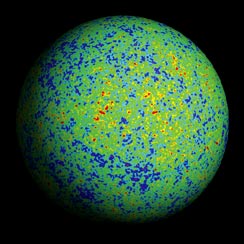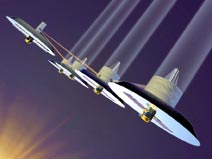|

ABOVE: This is our best guess as to what the Cosmic Microwave Background looks like . . . . Our entire observable universe is inside this sphere of radius 13.3 billion light-years, with us at the center. Space continues outside the sphere, but this opaque glowing wall of hydrogen plasma hides it from our view. This censorship is frustrating, since if we could see merely 380000 light-years beyond it, we would behold the beginning of the universe. Light from still further away would not yet have had time to reach us, but most inflation theories predict that space is infinite. (Note for pundits: These "distances" are merely light travel times. After emitting the CMB 13.3 billion years ago, the sphere above has kept expanding and is currently about 40 billion light-years away; its comoving radius is, was and always will be 40 billion light years.) Courtesy of Max Tegmark, University of Pennsylvania.
TOP of PAGE: Stretched Spiral NGC 6872 measures over 700,000 light years across from top to bottom, one of the largest barred spiral galaxies known, Credit: VLT/European Southern Observatory.
RIGHT: The planned 2014 Terrestrial Planet Finder could lead the search for Earth-like worlds, Credit: NASA's Goddard Space Flight Center.
| | |  | In pursuing research at the boundary between science and religion, the Foundation seeks to unite credible and rigorous science with the exploration of humanity’s basic spiritual and religious quests. Working closely with scientists, theologians, medical professionals, philosophers and other scholars, the Foundation encourages substantive dialogue in order to stimulate research and reflection on the relationship between science and religion. The Foundation especially seeks to stimulate rigorous scholarly/scientific advances that increase understanding of the ultimate aspects of human purpose, and of the vast potential for creativity and progress, which can be inspired by the collaboration of science and religion.
 Many of the projects supported by the Foundation have provided leading scholars with the opportunity for sustained reflection on important topics at the boundaries of science. Take the case of Paul Davies, a leading British physicist who published The Mind of God in 1992, one of the classic explorations in the field of science and religion. The book explored the degree to which scientific evidence pointed to a rational foundation for the universe and the sense in which this foundation could be referred to as “God.” For these and other explorations, Davies won the Templeton Prize in 1995. Many of the projects supported by the Foundation have provided leading scholars with the opportunity for sustained reflection on important topics at the boundaries of science. Take the case of Paul Davies, a leading British physicist who published The Mind of God in 1992, one of the classic explorations in the field of science and religion. The book explored the degree to which scientific evidence pointed to a rational foundation for the universe and the sense in which this foundation could be referred to as “God.” For these and other explorations, Davies won the Templeton Prize in 1995.
 In 1998 Davies chaired a meeting of leading scientists and theologians on the topic of “Many Worlds.” He was joined for the meeting in the Bahamas by Freeman Dyson, Sir Martin Rees, Lee Smolin, Nobel laureate Christian de Duve and others, all of whom collaborated on a popular book of essays titled, appropriately, Many Worlds. The deep question behind the symposium was that of design. We live in a universe that appears to have been designed for life. But this might be an illusion. There could be many worlds and we happen to occupy one where life is possible. The Many Worlds hypothesis explains, or explains away, perhaps, the mysterious fine-tuning of this world for life. In 1998 Davies chaired a meeting of leading scientists and theologians on the topic of “Many Worlds.” He was joined for the meeting in the Bahamas by Freeman Dyson, Sir Martin Rees, Lee Smolin, Nobel laureate Christian de Duve and others, all of whom collaborated on a popular book of essays titled, appropriately, Many Worlds. The deep question behind the symposium was that of design. We live in a universe that appears to have been designed for life. But this might be an illusion. There could be many worlds and we happen to occupy one where life is possible. The Many Worlds hypothesis explains, or explains away, perhaps, the mysterious fine-tuning of this world for life.
Davies chaired a subsequent initiative a year later in Sante Fe, New Mexico, on Complexity and Design. Leading thinkers like Stuart Kauffman, Harold Morowitz, and Gregory Chaitin joined Davies in an open-ended exploration of the origins of design and complexity in nature. A few months later the Foundation announced a multimillion- dollar initiative to fund mainstream scientific research projects focused on the question of “fine-tuning.” Long-range research projects took root in major universities in America and around the world: Stanford, Tufts, MIT, Princeton, New South Wales, Cambridge, and others.
Recipients of grant funds included leading scholars such as Andrei Linde, Bernard Carr, Neil Turok, and Mario Livio. Dr. John Donoghue of the University of Massachusetts, Amherst, received funds to look at the strange possibility that the laws of nature may vary throughout the universe; maybe we cannot extrapolate the laws discovered locally to the entire universe. Says Donoghue in an interview with Science & Theology News, “Everybody thinks that the universe is the same everywhere. This would make our part of the universe not so special anymore.”
|